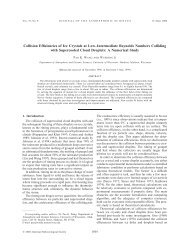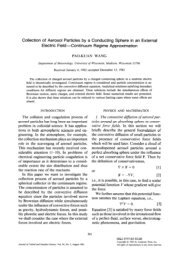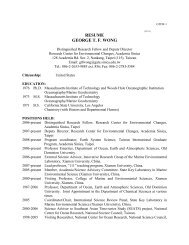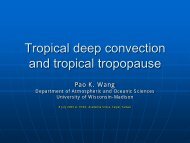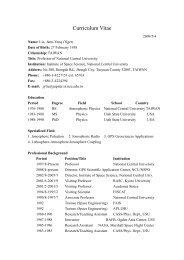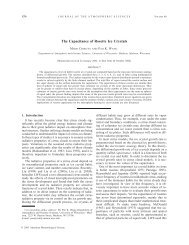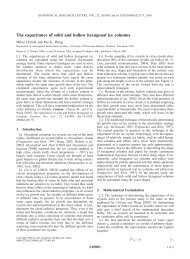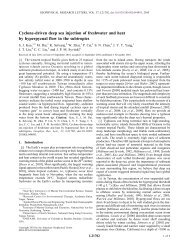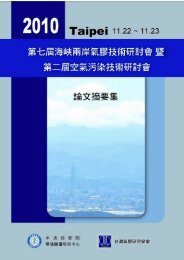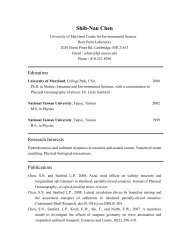Regional Tropical Precipitation Change ... - Academia Sinica
Regional Tropical Precipitation Change ... - Academia Sinica
Regional Tropical Precipitation Change ... - Academia Sinica
Create successful ePaper yourself
Turn your PDF publications into a flip-book with our unique Google optimized e-Paper software.
4216 JOURNAL OF CLIMATE VOLUME 19<br />
for some time that the sum of p s and p q terms<br />
has such a strong cancellation between large terms that<br />
estimation of the former from data interpolated to pressure<br />
levels can yield substantial error in the sum, and<br />
that contributions of transient terms can be nonnegligible<br />
(Neelin 1987). Overcoming these issues, as well as<br />
theoretical challenges in how to interpret cases where<br />
the conditions used in this section must be relaxed, is<br />
the subject of ongoing work. Here, working with standard<br />
diagnostics from an existing run, we side step these<br />
problems by focusing on key individual terms that are<br />
identified with particular mechanisms.<br />
c. Diagnosis<br />
FIG. 8. Same as in Fig. 4 except for moisture anomalies (g kg 1<br />
in the 1000–900-hPa layer in (a) JJA and (c) DJF and the 900–<br />
700-hPa layer in (b) JJA and (d) DJF. Climatological winds in<br />
1961–90 near margins of convective regions are also plotted for<br />
the same layer averages. The thick solid line is the 6 mm day 1<br />
contour of the precipitation climatology in 1961–90.<br />
In the study of CN04, QE mediation initiates a process<br />
that leads to anomalous precipitation under global<br />
warming. When the troposphere warms, low-level<br />
moisture tends to increase to maintain convective quasi<br />
equilibrium in convective regions. However, QE mediation<br />
does not occur in nonconvective regions where<br />
moisture is controlled by different processes, such as a<br />
balance between low-level divergence and evaporation<br />
that induce smaller increases in low-level moisture. The<br />
different processes controlling low-level moisture in<br />
convective and nonconvective regions create horizontal<br />
gradients of moisture anomalies. Thus, we first examine<br />
the distribution of low-level moisture in the GHG experiment.<br />
Then, (v · q) and (v · T) in the lower<br />
troposphere will be examined for the upped-ante<br />
mechanism. Finally, the term p q associated with<br />
the rich-get-richer mechanism and the p q feedbacks<br />
should also be examined in the ECHAM4/<br />
OPYC3 simulations.<br />
Figure 8 shows anomalous moisture in the ABL<br />
(1000–900 hPa) and a free atmospheric layer just above<br />
the ABL (900–700 hPa). The results indicate that moisture<br />
over the convective regions is enhanced not only in<br />
the ABL, but also in the free troposphere. The moisture<br />
increases are comparable in magnitude between<br />
the ABL and the 900–700-hPa layer with both having<br />
maximum values in deep convection regions. Moisture<br />
in the ABL increases due to surface warming even over<br />
nonconvective regions, but the ABL moisture increases<br />
are larger in convective regions (the thick solid line in<br />
Fig. 8.), enhanced by QE mediation. Convection can<br />
further transport moisture into the free atmosphere.<br />
Moisture anomalies the 900–700-hPa layer thus have<br />
very sharp maxima in convective regions. These moisture<br />
anomalies create horizontal gradients of anomalous<br />
moisture from convective regions to nonconvective<br />
regions. Besides the maximum moisture anomalies in<br />
convective regions, local maxima of the low-level moisture<br />
anomalies are also found over the central and eastern<br />
Pacific where the positive precipitation anomalies<br />
also have a maximum. Another set of local maxima of<br />
low-level moisture anomalies is found in the boreal<br />
summer over the northern margin of the convective<br />
region from Africa, across the Arabian Peninsula, to<br />
the northern Indian Peninsula. Note that the Asia summer<br />
regions also have a local maximum of low-level<br />
moisture anomalies. Thus, the maximum moisture



